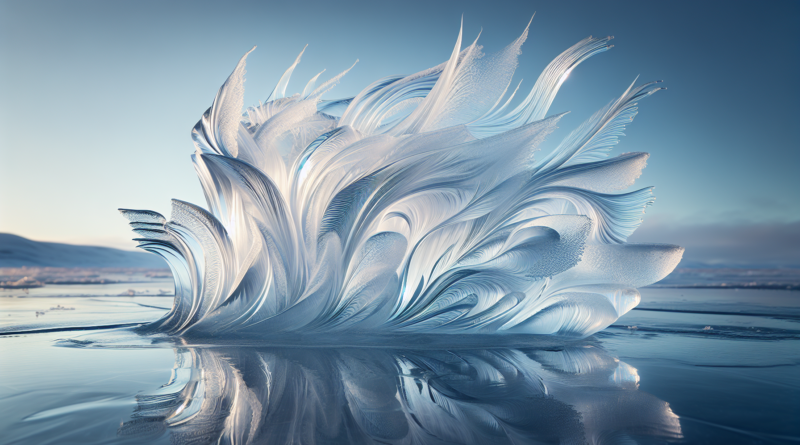Ephemeral Ice Sculpture
Imagine standing in a winter wonderland surrounded by stunning works of art, each one crafted from ice. These ephemeral ice sculptures captivate your senses and leave you in awe of the beauty that can be created with frozen water. From delicate and intricate designs to towering and majestic forms, these sculptures are a testament to the creativity and skill of the artists who bring them to life, if only for a short time. In a world where artistry knows no bounds, ephemeral ice sculpture stands out as a unique and captivating art form that delights both the eye and the imagination.
Ephemeral Ice Sculpture

What is Ephemeral Ice Sculpture?
Ephemeral ice sculpture is an artistic form of expression that involves the creation of intricate and delicate sculptures using ice as the main medium. These sculptures are temporary in nature, as they are subject to melting and are meant to be enjoyed for a limited period of time. Ephemeral ice sculpture combines the beauty of ice with the creativity and skill of the artist, resulting in breathtaking works of art that captivate the senses and leave a lasting impression.
History of Ephemeral Ice Sculpture
The origins of ephemeral ice sculpture can be traced back to ancient civilizations such as the Mesopotamians and Egyptians, who used ice to create decorative objects and sculptures for religious and cultural ceremonies. However, it was not until the late 19th and early 20th centuries that ice sculpture emerged as a recognized art form. In the early days, ice sculptures were mainly used as elaborate centerpieces at grand events and banquets, showcasing the wealth and status of the hosts.
Tools and Materials Needed for Ephemeral Ice Sculpture
Creating ephemeral ice sculptures requires a specific set of tools and materials. Some of the essential tools include ice carving chisels of various shapes and sizes, chainsaws with specialized ice cutting attachments, blowtorches for melting and smoothing the ice surfaces, and hand saws for finer details. Additionally, artists may use molds, freezing chambers, and rubber gloves to shape and mold the ice as desired. It’s important to note that safety gear such as goggles and protective gloves should always be worn when working with ice carving tools.
In terms of materials, clear block ice is the preferred choice for ice sculptures due to its transparency and strength. Artists may also use colored ice blocks to add vibrancy and visual interest to their sculptures. Water is another important material, as it can be used to bond pieces of ice together and create intricate details.
Techniques for Creating Ephemeral Ice Sculpture
Creating an ephemeral ice sculpture requires the mastery of various techniques. The first step is to create a design or concept, which serves as a blueprint for the sculpture. Artists often sketch their ideas on paper before translating them to ice.
Once the design is finalized, the process of carving and shaping the ice begins. This involves using chisels and saws to remove excess ice and create the desired shape. Chainsaws are often used for larger and more complex sculptures, allowing artists to quickly and efficiently shape the ice.
Finer details and textures are then added using smaller carving tools. Blowtorches may be used to melt and smooth the ice surfaces, creating a polished and glossy finish. Some artists also incorporate lighting effects into their sculptures, enhancing the overall visual impact.
Popular Themes and Designs in Ephemeral Ice Sculpture
Ephemeral ice sculptures can be created in a wide range of themes and designs, limited only by the artist’s imagination. Popular themes include nature-inspired sculptures such as animals, plants, and landscapes, as well as abstract and geometric designs that showcase the beauty of the ice itself. Additionally, ice sculptures based on pop culture references, historical figures, and fairy tales are also common.
Some artists specialize in creating functional ice sculptures, such as ice bars, ice dining tables, and ice luges for beverage service. These sculptures not only serve as stunning works of art but also provide a unique and memorable experience for guests.
Challenges and Considerations in Ephemeral Ice Sculpture
Creating ephemeral ice sculptures presents a unique set of challenges and considerations for artists. The main challenge is the inherently temporary nature of ice sculptures. As the sculptures are subject to melting, artists must work quickly and efficiently to bring their vision to life. They also need to carefully consider the location and environment in which the sculpture will be displayed to ensure optimal conditions for preservation.
Furthermore, working with ice requires a deep understanding of its properties and behavior. Artists need to take into account factors such as temperature and humidity, as these can affect the stability and lifespan of the sculpture. It’s also important to consider safety precautions when working with ice carving tools, as the process can be physically demanding and potentially hazardous.
Steps to Create an Ephemeral Ice Sculpture
Creating an ephemeral ice sculpture involves a series of steps, each requiring precision and attention to detail. Here is a general outline of the process:
-
Design: Start by sketching out your design idea on paper or using digital software. Consider the size, shape, and level of detail you want to achieve.
-
Block Selection: Choose a clear block of ice that is suitable for your design. Ensure that the block is free from impurities and has a uniform texture.
-
Sculpting: Begin shaping the ice using chisels, saws, and chainsaws. Remove excess ice and gradually refine the shape according to your design. Take breaks to assess the progress and make adjustments as needed.
-
Details and Textures: Use smaller carving tools to add finer details and textures to the sculpture. Pay attention to creating depth and dimension, enhancing the overall visual impact.
-
Smoothing: Melt and smooth the ice surfaces using a blowtorch. This helps create a polished and glossy finish, enhancing the clarity and transparency of the ice.
-
Preservation: Once the sculpture is complete, take steps to preserve it for as long as possible. This may include placing the sculpture in a controlled environment, such as a refrigerated room, and applying a protective coating to slow down the melting process.
Tips and Tricks for Ephemeral Ice Sculpture
-
Plan ahead: Before starting a project, spend time brainstorming ideas and sketching out your design. This will help you visualize the end result and make the sculpting process smoother.
-
Stay organized: Keep your tools and workspace tidy to maximize efficiency. Arrange your tools in a way that allows easy access and use containers to hold smaller carving tools.
-
Practice safety precautions: Always wear the necessary safety gear, such as goggles and protective gloves, to prevent injuries while working with ice carving tools. Take breaks and stay hydrated to avoid fatigue.
-
Experiment with lighting: Incorporating lighting effects into your ice sculpture can dramatically enhance its visual impact. Consider using LED lights or colored gels to create a mesmerizing glow.
-
Embrace imperfections: Ice sculptures are inherently fragile and prone to flaws. Embrace any imperfections or unexpected results, as they can add character and uniqueness to your work.
Different Styles of Ephemeral Ice Sculpture
Ephemeral ice sculptures can be created in various styles, each showcasing the artist’s creativity and aesthetic preferences. Some popular styles include:
-
Realistic: This style focuses on creating ice sculptures that closely resemble their real-life counterparts. Artists use intricate carving techniques and attention to detail to achieve a high level of realism.
-
Abstract: Abstract ice sculptures explore shapes, lines, and textures, often evoking emotions and pushing the boundaries of traditional sculpting. This style allows for more experimental and unconventional designs.
-
Minimalist: Minimalist ice sculptures incorporate simplicity and clean lines, often showcasing the beauty of the ice itself. These sculptures rely on precise carving techniques and carefully controlled lighting to create a striking visual impact.
-
Interactive: Interactive ice sculptures invite viewer participation and engagement. They may feature elements that can be manipulated or touched, allowing for a multi-sensory experience.
Famous Ephemeral Ice Sculptors
Over the years, several artists have made a name for themselves in the world of ephemeral ice sculpture. Their works continue to inspire and push the boundaries of the art form. Some notable ice sculptors include:
-
Shintaro Okamoto: A Japanese sculptor known for his intricate ice sculptures that often depict mythical creatures and fantastical landscapes. Okamoto is celebrated for his attention to detail and ability to evoke a sense of wonder with his creations.
-
Junichi Nakamura: Hailing from Japan, Nakamura is renowned for his delicate and ethereal ice sculptures. He often incorporates elements of nature, such as flowers and animals, into his designs, resulting in breathtaking works of art.
-
LudoSculpt: LudoSculpt, based in France, is recognized for its innovative and boundary-pushing ice sculptures. Their designs blend traditional sculpting techniques with modern technology, creating visually stunning and immersive experiences.
-
Team Latvia: Comprised of a group of talented ice sculptors, Team Latvia has won numerous awards and accolades for their impressive and intricate ice sculptures. They are known for their unique and creative designs, often incorporating elements of movement and balance.
In conclusion, ephemeral ice sculpture is a captivating art form that combines the transitory nature of ice with the creativity and skill of the artist. From its ancient origins to its modern evolution, ice sculpture continues to captivate and inspire with its breathtaking beauty. Whether it’s a realistic depiction or an abstract creation, ephemeral ice sculptures leave a lasting impression on those lucky enough to witness their fleeting existence. So next time you encounter an ephemeral ice sculpture, take a moment to appreciate the delicate artistry and the beauty of impermanence.




